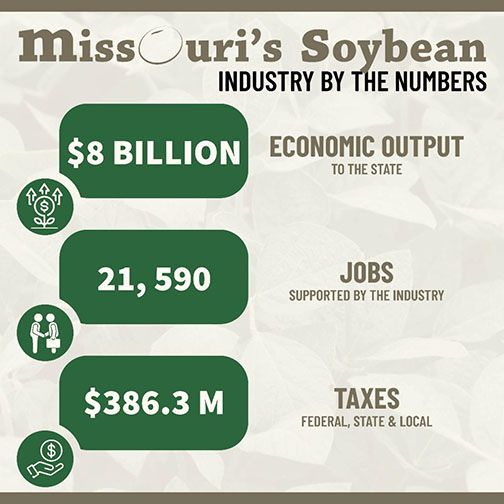JEFFERSON CITY, Mo. – According to a recent independent economic study, the soybean industry continues to remain as a top economic engine for the Show-Me State. The results of the 2022 study found that the Missouri soybean industry provides more than $8 billion in economic output to the state.
“The study allows us to quantify the impact the soybean industry provides to the state, regional and county levels,” said Matt Amick, director of market development. “As we visit with policymakers, stakeholders and consumers, this data is valuable to be able to showcase the incredible role of the soybean industry as an economic driver for Missouri and beyond.”
The economic impact study is broken down into two core areas: soybean farming and soybean processing, such as crush, oil refining and biodiesel. Within this study, economic output is defined as sales, while value-added is defined as sales minus inputs.
According to the research, the Missouri soybean industry contributed $8.093 billion in economic output, $3.106 billion in value-added and $386.3 million in federal, state and local taxes. Additionally, the industry supports 21,590 jobs and $1.199 billion in labor income.
Missouri soybean farming contributed $4.416 billion in economic output, $2.521 in value-added and $315.6 million in federal, state and local taxes, while supporting 18,046 jobs.
Soybean processing contributed $3.677 billion in economic output, $585 million in value-added and $70.7 million in federal, state and local taxes, while supporting 3,544 jobs.
The top counties by economic output were Buchanan ($691.6 million), Ralls ($649.9 million), Audrain ($629.8 million), New Madrid ($612.3 million) and Jackson ($396.5 million).
“The power is behind the numbers,” said Gary Wheeler, CEO and executive director. “Our goal at Missouri Soybeans is to ensure soybean producers persist and prove profitable in their operations, while holding steady as the state’s economic powerhouse. We want to put the right tools in their toolbox and devote dollars to research that ultimately aids in their ability to be this engine.”
The study further breaks down numbers by county, Congressional district, state Senate district, state House district and grower district. You can find a full download of the information at mosoy.org.

